How Worksheets Enhance Skill Development
Worksheets have been a cornerstone of education for decades, providing a structured and effective way to teach, practice, and assess various skills. These simple tools do much more than reinforce academic concepts—they play a critical role in helping students develop essential skills that extend beyond the classroom. From cognitive abilities to creativity, worksheets serve as versatile tools that cater to diverse learning needs and goals.
In this article, we’ll explore how worksheets enhance skill development and why they remain an indispensable part of modern education.
1. Reinforcing Foundational Skills
Worksheets are instrumental in building the basics, especially in early education.
- Math Skills: Practice sheets with exercises like addition, subtraction, or multiplication solidify understanding and improve accuracy.
- Language Skills: Worksheets focused on reading comprehension, grammar, and writing help students master the fundamental building blocks of communication.
- Science Skills: Activities such as labeling diagrams or solving puzzles encourage observation and understanding of scientific concepts.
By repeating these core exercises, students gain confidence and fluency in essential academic skills.
2. Encouraging Critical Thinking
Well-designed worksheets go beyond rote learning to foster critical thinking.
- Problem-Solving Tasks: Math word problems, logic puzzles, and open-ended questions challenge students to analyze and strategize.
- Decision-Making Activities: Worksheets that involve choosing the best solution or evaluating different scenarios develop decision-making abilities.
- Cause-and-Effect Exercises: These tasks encourage students to think deeply about the relationships between events, enhancing analytical skills.
Worksheets help students transition from simply recalling facts to applying knowledge in thoughtful, meaningful ways.
3. Enhancing Creativity
Creative worksheets allow students to explore their imagination and originality.
- Art-Based Worksheets: Coloring pages, design tasks, and drawing activities inspire creativity while improving fine motor skills.
- Story Prompts: Creative writing worksheets encourage students to craft stories, build characters, and express their ideas.
- Brainstorming Activities: Worksheets that involve mind maps or idea generation promote innovative thinking.
These activities not only make learning enjoyable but also nurture the creative potential of students.
4. Developing Problem-Solving Skills
Worksheets are particularly effective in teaching problem-solving, a skill essential for academic and real-life success.
- Step-by-Step Problem Solving: Worksheets break down complex tasks into smaller steps, teaching students how to approach challenges systematically.
- Scenario-Based Questions: These simulate real-world problems, encouraging students to think critically and come up with practical solutions.
- Trial-and-Error Learning: Worksheets give students the freedom to experiment, make mistakes, and learn from them in a low-stress environment.
By regularly engaging in such activities, students develop resilience and the ability to tackle challenges with confidence.
5. Supporting Independent Learning
Worksheets empower students to take ownership of their education.
- Self-Guided Practice: With clear instructions, students can complete worksheets independently, building self-reliance.
- Time Management: Completing worksheets within a set timeframe teaches students how to manage their time effectively.
- Goal Setting: Progression through increasingly challenging worksheets encourages students to set and achieve goals.
This independence fosters a lifelong love of learning and prepares students for self-directed success in the future.
6. Strengthening Attention to Detail
Worksheets help students focus and pay attention to detail through structured tasks that require precision.
- Error Identification: Grammar correction or proofreading worksheets teach students to spot mistakes.
- Diagram Labeling: Science or geography worksheets requiring accurate labeling hone observational skills.
- Matching Activities: These tasks sharpen focus and improve memory retention.
Attention to detail is a critical skill that benefits students in academic settings and beyond.
7. Catering to Diverse Learning Styles
Worksheets accommodate different learning preferences, ensuring all students benefit.
- Visual Learners: Graphics, charts, and diagrams make worksheets accessible to visual learners.
- Kinesthetic Learners: Hands-on activities like cutting, sorting, or coloring engage tactile learners.
- Auditory Learners: Worksheets paired with discussions or audio instructions complement auditory learning styles.
By addressing these diverse needs, worksheets ensure inclusive and effective learning experiences.
8. Offering Measurable Progress
Worksheets provide tangible evidence of skill development.
- Track Growth: Teachers and parents can assess completed worksheets to identify strengths and areas for improvement.
- Measure Understanding: Regular practice helps evaluate how well students grasp key concepts.
- Celebrate Achievements: Reviewing finished worksheets boosts confidence and motivates further effort.
These measurable outcomes make worksheets an invaluable tool for skill assessment and feedback.
Conclusion
Worksheets are far more than simple assignments—they are powerful tools for enhancing skill development in students of all ages. From reinforcing foundational knowledge to fostering creativity and critical thinking, worksheets equip students with the skills they need to succeed academically and in life.
By integrating well-designed worksheets into education, teachers and parents can provide a versatile, accessible, and effective means of supporting skill growth. Explore the transformative potential of worksheets today and see how they can help your students thrive.


Facebook Comments